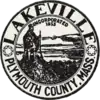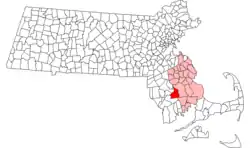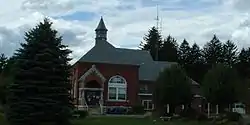Lakeville, Massachusetts
Lakeville is a town in Plymouth County, Massachusetts, United States. The population was 10,602 at the 2010 census.[1]
Lakeville, Massachusetts | |
|---|---|
 Assawompset Pond, Lakeville | |
 Seal | |
 Location in Plymouth County in Massachusetts | |
| Coordinates: 41°50′45″N 70°57′00″W | |
| Country | United States |
| State | Massachusetts |
| County | Plymouth |
| Settled | 1717 |
| Incorporated | May 13, 1853 |
| Government | |
| • Type | Open town meeting |
| Area | |
| • Total | 36.1 sq mi (93.6 km2) |
| • Land | 29.6 sq mi (76.6 km2) |
| • Water | 6.6 sq mi (17.0 km2) |
| Elevation | 90 ft (27 m) |
| Population (2017) | |
| • Total | 11,424 |
| • Density | 320/sq mi (120/km2) |
| Time zone | UTC-5 (Eastern) |
| • Summer (DST) | UTC-4 (Eastern) |
| ZIP code | 02347 |
| Area code(s) | 508 / 774 |
| FIPS code | 25-33920 |
| GNIS feature ID | 0618344 |
| Website | www.lakevillema.org |
For geographic and demographic information on the village of North Lakeville, please see the article North Lakeville, Massachusetts.
History

Lakeville was settled in 1717 as a western parish of Middleborough. It was incorporated as a separate town in 1853. The town's name comes from the system of lakes in the town, including Assawompset Pond, Great Quittacas Pond, Little Quittacas Pond, Pocksha Pond, and Long Pond. Long Pond is the source of the Acushnet River, and Assawompsett Pond is the source of the Nemasket River, which feeds the Taunton River. Ocean Spray is headquartered in Lakeville. Lakeville is also commonly referred to as "The Promised Land."
Geography
According to the United States Census Bureau, the town has a total area of 36.1 square miles (93.6 km2), of which 29.6 square miles (76.6 km2) is land and 6.6 square miles (17.0 km2), or 18.17%, is water.[2] Lakeville is irregularly shaped, bordered by Middleborough to the northeast and east, Rochester to the southeast, Freetown to the south and southwest, and Berkley and Taunton to the west. Its borders with Taunton, Berkley and Freetown are also a central section of the western borders of Plymouth County. Lakeville is roughly at the center of what is considered Southeastern Massachusetts, and is approximately 20 miles (32 km) west of Plymouth, 20 miles (32 km) north of New Bedford, 30 miles (48 km) east of Providence, Rhode Island, and 40 miles (64 km) south of Boston.
The town's geography is dominated by its namesake lakes, which are referred to as "ponds" in general usage. In addition to the main bodies of water and their feeder brooks and rivers, there are also several smaller ponds, as well as many brooks and swamps, including the Casual Swamp and the Cedar Swamp, which is protected as a part of the Assonet Cedar Swamp Wildlife Management Area, which is operated by the Massachusetts Audubon Society. There are also several small conservation areas, four country clubs and two parks, including the Ted Williams Camp, which was once the site of a summer baseball camp run by Ted Williams. According to "Lakeville, Massachusetts Gravestone Inscriptions 1711-2003" by Jean Douillette, there are 31 known cemeteries in Lakeville, or almost 1 per square mile.
The body of John Sassamon, advisor to Governor Josiah Winslow, was discovered beneath the ice of Assawompsett Pond. He was believed to have been murdered, and three Native Americans were arrested. On the testimony of only one witness (contrary to English law, which required the testimony of at least two witnesses in a murder trial), the three were sentenced to death by hanging. When the sentence was carried out, Tobias, senior counselor to the Pokanoket sachem King Philip, and a second supposed accomplice died. When the attempt was made to carry out the sentence on the third "accomplice" - Tobias's son - the rope broke and he was imprisoned, having first confessed to the killings. His confession is widely believed to have been coerced.
The death of John Sassamon and the subsequent trial and execution of the Native Americans - while not the cause of King Philip's War and the bloodshed that followed - nonetheless probably contributed to the ardor of the participants.
Demographics
| Year | Pop. | ±% |
|---|---|---|
| 1860 | 1,160 | — |
| 1870 | 1,159 | −0.1% |
| 1880 | 1,008 | −13.0% |
| 1890 | 935 | −7.2% |
| 1900 | 958 | +2.5% |
| 1910 | 1,141 | +19.1% |
| 1920 | 1,419 | +24.4% |
| 1930 | 1,574 | +10.9% |
| 1940 | 1,780 | +13.1% |
| 1950 | 2,066 | +16.1% |
| 1960 | 3,209 | +55.3% |
| 1970 | 4,376 | +36.4% |
| 1980 | 5,931 | +35.5% |
| 1990 | 7,785 | +31.3% |
| 2000 | 9,821 | +26.2% |
| 2010 | 10,602 | +8.0% |
| * = population estimate. Source: United States Census records and Population Estimates Program data.[3][4][5][6][7][8][9][10][11] | ||
As of the census[12] of 2000, there were 9,821 people, 3,292 households, and 2,659 families residing in the town. The population density was 328.4 people per square mile (126.8/km2). There were 3,662 housing units at an average density of 122.5 per square mile (47.3/km2). The racial makeup of the town was 97.29% White, 0.31% African American, 0.14% Native American, 0.59% Asian, 0.01% Pacific Islander, 0.50% from other races, and 1.16% from two or more races. Hispanic or Latino of any race were 1.06% of the population.
The most common ancestries in Lakeville are: Irish (23.2%), English (20.1%), French (12.9%), Italian (11.9%), Portuguese (11.4%) and French Canadian (10.1%). 3.8% of Lakeville's residents are foreign-born.[13]
There were 3,292 households, out of which 40.0% had children under the age of 18 living with them, 69.7% were married couples living together, 8.0% had a female householder with no husband present, and 19.2% were non-families. 14.7% of all households were made up of individuals, and 6.2% had someone living alone who was 65 years of age or older. The average household size was 2.91 and the average family size was 3.24.
In the town, the population was spread out, with 27.4% under the age of 18, 5.7% from 18 to 24, 31.1% from 25 to 44, 24.4% from 45 to 64, and 11.3% who were 65 years of age or older. The median age was 38 years. For every 100 females, there were 93.9 males. For every 100 females age 18 and over, there were 91.1 males. Of the population 25 years and older in Lakeville, 87.2% have a high school degree or higher. 32.7% of this demographic group has a bachelor's degree or higher. 11% of Lakeville residents 25 years or older have a graduate or professional degree. The average person's commute to work is 33.8 minutes and 2.6% of the town's population above the age of 25 is unemployed.
The median income for a household in the town was $70,495, and the median income for a family was $75,838. Males had a median income of $51,321 versus $31,374 for females. The per capita income for the town was $26,046. About 1.9% of families and 3.0% of the population were below the poverty line, including 2.8% of those under age 18 and 8.5% of those age 65 or over.
Lakeville's median household income and the medium house value are above the Massachusetts state average.[13]
Government

Lakeville is governed with the Open Town Meeting form of government, and is led by a town administrator and a board of selectmen. The town has its own police department and a single fire station, located next to the town hall. The "new" library is located behind the old town hall, just across Route 18 from its former location at the junction of Routes 18 and 105. The town of Lakeville also has other services, such as a Council on Aging and a historical commission. Lakeville is one of the few town in Massachusetts to have more registered Republicans than registered Democrats.[14]
On the state level, Lakeville is represented in the Massachusetts House of Representatives as a part of the Twelfth Bristol District. The town is represented by Senator Michael J. Rodrigues (D-Westport), as a part of the First Bristol and Plymouth District, which also includes Fall River, Freetown, Rochester, Somerset, Swansea and Westport.[15][16]
On the national level, Lakeville is a part of Massachusetts's 4th congressional district, and is currently represented by Joseph P. Kennedy III. The state's senior (Class I) member of the United States Senate, elected in 2012, is Elizabeth Warren. The junior (Class II) senator, elected in 2013, is Ed Markey.
Education
Since 1959, Lakeville has shared its school department with Freetown, creating the Freetown - Lakeville Regional School District. Lakeville operates several schools for its school aged population. Assawompsett Elementary School is operated jointly with Freetown for grades K-3. The George R. Austin Intermediate School is operated jointly with Freetown for grade 4 and 5. Freetown-Lakeville Middle School is operated jointly with Freetown for grades 6–8, and Apponequet Regional High School is jointly operated with Freetown for grades 9-12. Apponequet's colors are navy, white, and red, their nickname is the "Lakers," and their mascot was a Wampanoag brave, but after a sensitivity issue among the faculty at Apponequet, it was changed to an "A". The school, like several others in the region, used to use the spear logo made famous by Florida State University and the Washington Redskins for its athletics marks, but this was deemed to promote violence, so it was replaced with the "A". Their teams compete in the South Coast Conference, and their chief rival is Old Rochester Regional High School in Mattapoisett.
Transportation
Massachusetts Route 140, a four-lane divided highway, passes through the town on its trip between Route 24 in nearby Taunton and Interstate 195 in New Bedford. The town is also crossed by Route 18, Route 79 and Route 105, as well as a short, 0.4-mile (0.64 km) stretch of U.S. Route 44 in the far northern point of town. Route 79's eastern terminus is at its intersection with Route 105 on the town line. Additionally, three exits of Interstate 495 are located just over the town line in Middleborough, granting access to Routes 44, 18 and 105 (from north to south in order).
In addition to its highways, the terminus of the Middleborough-Lakeville Line of the MBTA's commuter rail is along the town's border (the rail itself passes along the town line; the parking lots are entirely within Lakeville). There is also a spur off that line, heading due west to Taunton, which is operated by CSX Transportation. This spur links the two main lines of the railroad in southeastern Massachusetts; the easternmost heads to Cape Cod via the line used by the MBTA, and the westernmost proceeds to split in Taunton, sending two lines towards Fall River and New Bedford, respectively. The New Bedford line also passes through the town on its west side. The town has no air facilities of its own. The nearest private airfield is in Taunton; the nearest regional airport is in New Bedford, and the nearest national and international airport is T. F. Green Airport in Warwick, Rhode Island.
References
- "Profile of General Population and Housing Characteristics: 2010 Demographic Profile Data (DP-1): Lakeville town, Plymouth County, Massachusetts". United States Census Bureau. Retrieved March 20, 2012.
- "Geographic Identifiers: 2010 Demographic Profile Data (G001): Kingston town, Plymouth County, Massachusetts". United States Census Bureau. Retrieved March 20, 2012.
- "TOTAL POPULATION (P1), 2010 Census Summary File 1, All County Subdivisions within Massachusetts". United States Census Bureau. Archived from the original on February 12, 2020. Retrieved September 13, 2011.
- "Massachusetts by Place and County Subdivision - GCT-T1. Population Estimates". United States Census Bureau. Archived from the original on November 3, 2011. Retrieved July 12, 2011.
- "1990 Census of Population, General Population Characteristics: Massachusetts" (PDF). US Census Bureau. December 1990. Table 76: General Characteristics of Persons, Households, and Families: 1990. 1990 CP-1-23. Archived from the original (PDF) on December 7, 2013. Retrieved July 12, 2011.
- "1980 Census of the Population, Number of Inhabitants: Massachusetts" (PDF). US Census Bureau. December 1981. Table 4. Populations of County Subdivisions: 1960 to 1980. PC80-1-A23. Retrieved July 12, 2011.
- "1950 Census of Population" (PDF). 1: Number of Inhabitants. Bureau of the Census. 1952. Section 6, Pages 21-10 and 21-11, Massachusetts Table 6. Population of Counties by Minor Civil Divisions: 1930 to 1950. Retrieved July 12, 2011. Cite journal requires
|journal=(help) - "1920 Census of Population" (PDF). Bureau of the Census. Number of Inhabitants, by Counties and Minor Civil Divisions. Pages 21-5 through 21-7. Massachusetts Table 2. Population of Counties by Minor Civil Divisions: 1920, 1910, and 1920. Retrieved July 12, 2011.
- "1890 Census of the Population" (PDF). Department of the Interior, Census Office. Pages 179 through 182. Massachusetts Table 5. Population of States and Territories by Minor Civil Divisions: 1880 and 1890. Retrieved July 12, 2011.
- "1870 Census of the Population" (PDF). Department of the Interior, Census Office. 1872. Pages 217 through 220. Table IX. Population of Minor Civil Divisions, &c. Massachusetts. Retrieved July 12, 2011.
- "1860 Census" (PDF). Department of the Interior, Census Office. 1864. Pages 220 through 226. State of Massachusetts Table No. 3. Populations of Cities, Towns, &c. Retrieved July 12, 2011.
- "U.S. Census website". United States Census Bureau. Retrieved 2008-01-31.
- https://www.sec.state.ma.us/ele/elepdf/enrollment_count_20200212.pdf
- Index of Legislative Representation by City and Town, from Mass.gov
- Station D-4, SP Middleborough
External links
| Wikivoyage has a travel guide for Lakeville (Massachusetts). |
| Wikimedia Commons has media related to Lakeville, Massachusetts. |
- Town of Lakeville official website
- Lakeville Public Library
- Lakeville Call, local newspaper
- Answer Book/Lakeville: "Everything you need to know"
- A site about Lakeville's cemeteries
